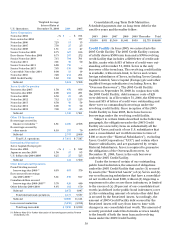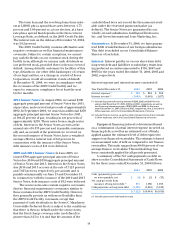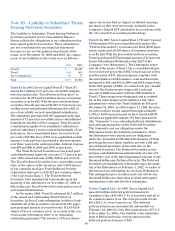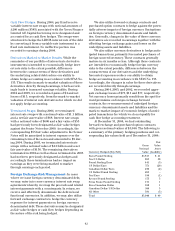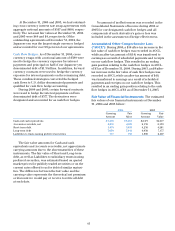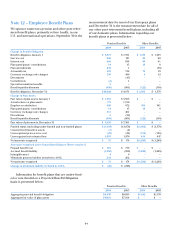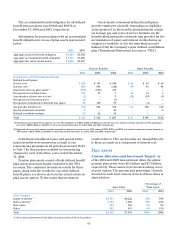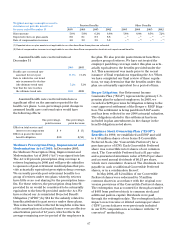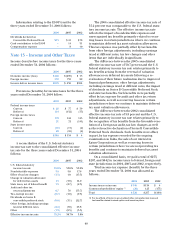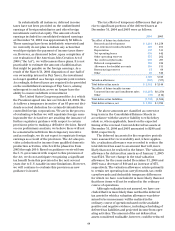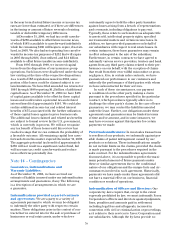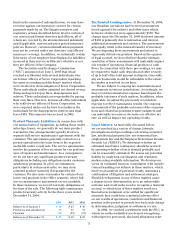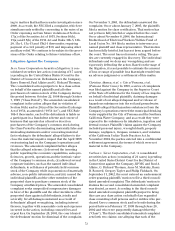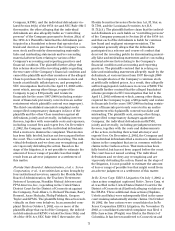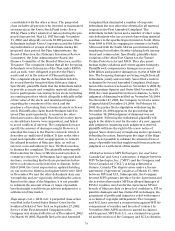Xerox 2004 Annual Report Download - page 69
Download and view the complete annual report
Please find page 69 of the 2004 Xerox annual report below. You can navigate through the pages in the report by either clicking on the pages listed below, or by using the keyword search tool below to find specific information within the annual report.
67
Weighted-average assumptions used to
determine net periodic benefit cost Pension Benefits Other Benefits
for years ended December 31 2005 2004 2003 2002 2005 2004 2003 2002
Discount rate 5.6% 5.8% 6.2% 6.8% 5.8% 6.0% 6.5% 7.2%
Expected return on plan assets 8.0 8.1 8.3 8.8 — (1) —(1) —(1) —(1)
Rate of compensation increase 4.0 3.9 3.9 3.8 — (2) —(2) —(2) —(2)
(1) Expected return on plan assets is not applicable to our other benefits as these plans are unfunded.
(2) Rate of compensation increase is not applicable to our other benefits as compensation levels do not impact earned benefits.
Assumed health care cost trend rates at
December 31
2004 2003
Health care cost trend rate
assumed for next year 11.9% 11.4%
Rate to which the cost trend
rate is assumed to decline
(the ultimate trend rate) 5.2% 5.2%
Year that the rate reaches
the ultimate trend rate 2011 2008
Assumed health care cost trend rates have a
significant effect on the amounts reported for the
health care plans. A one-percentage-point change in
assumed health care cost trend rates would have
the following effects:
One-percentage- One-percentage-
point increase point decrease
Effect on total service and
interest cost components $ 4 $ (3)
Effect on post-retirement
benefitobligation $ 60 $(52)
Medicare Prescription Drug, Improvement and
Modernization Act of 2003: In December 2003,
the Medicare Prescription Drug, Improvement and
Modernization Act of 2003 (“Act”) was signed into law.
The Act will provide prescription drug coverage to
retirees beginning in 2006 and will provide subsidies
to sponsors of post-retirement medical plans that pro-
vide actuarially equivalent prescription drug coverage.
We currently provide post-retirement benefits to a
group of retirees under twoplans whereby retirees
have little or no cost sharing for the prescription bene-
fits. For these retirees, the prescription drug benefit
provided by us would be considered to be actuarially
equivalent to the benefit provided under the Act. We
havereduced our Accumulated Projected Benefit
Obligation (“APBO”) by $64 for the subsidy related to
benefits attributed to past service under these plans.
This reduction will be reflected through the reduction
of the amortization of actuarial losses over an effective
amortization period of 12 years, which reflects the
average remaining service period of the employees in
the plan. We also provide postretirement benefits to
another group of retirees. We have not treated the
employer paid drug coverage under this plan as actu-
arially equivalent to the benefits provided under the
Act. This assessment was made prior to the recent
issuance of final regulations regarding the Act. When
we have completed our final review of these regula-
tions, we may determine that the benefits under this
plan are actuarially equivalent for a period of time.
Berger Litigation: Our Retirement Income
Guarantee Plan (“RIGP”) represents the primary U.S.
pension plan for salaried employees. In 2003, we
recorded a $239 provision for litigation relating to the
court approved settlement of the Berger v. RIGP litiga-
tion. The settlement is being paid from RIGP assets
and has been reflected in our 2004actuarial valuation.
The obligation related to this settlement has been
included in plan amendments in the change in the
benefitobligation noted above.
Employee Stock Ownership Plan (“ESOP”)
Benefits: In 1989, we established an ESOP and sold
to it 10 million shares of our Series B Convertible
Preferred Stock (the “Convertible Preferred”) for a
purchase price of $785. Each Convertible Preferred
share was convertible into 6 shares of our common
stock. The Convertible Preferred had a $1 par value
and a guaranteed minimum value of $78.25 per share
and accrued annual dividends of $6.25per share,
which were cumulativeif earned. The dividends were
payable in cash or additional Convertible Preferred
shares, or in a combination thereof.
In May 2004, all 6.2 million of our Convertible
Preferred shares were redeemed for 37 million
common shares in accordance with the original con-
version provisions of the Convertible Preferred shares.
The redemption was accounted for through a transfer
of $483 from preferred stock to common stock and
additional paid-in-capital. Dividends were paid
through the redemption date. The redemption had no
impact on net income or diluted earnings per share
(“EPS”) as such shares were previously included
in our EPScomputation in accordance with the “if
converted” methodology.



